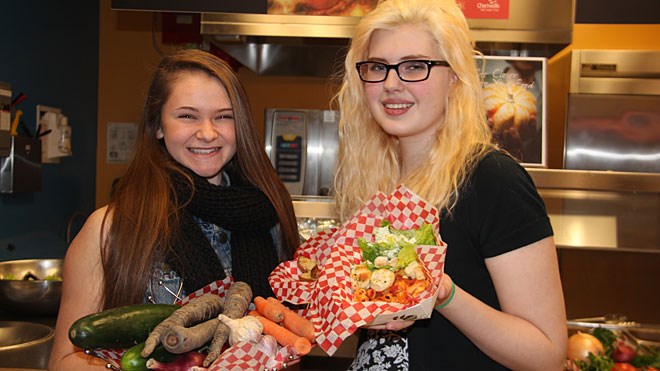On offer were the aforementioned potatoes, bocconcini penne with butternut squash, multi-coloured carrots and dip and apples with maple syrup.
This kind of food will become more common at Rainbow high school cafeterias.
Chartwells has partnered with Eat Local Sudbury — a co-operative grocery store and distributor of local foods — to regularly offer produce from local farms at the cafeterias.
As far as Mason is concerned, the food was a hit.
“I'm still enjoying the food I love, and I get to support my community as well,” she said.
During the winter months, Chartwells is making use of products such as local carrots, potatoes and cheese, but later on, there's also opportunities to use foods such as fresh lettuce and other vegetables.
“It's surprising how much product there actually is out there you can use this time of year when really nothing is growing,” said Mary Webb, Chartwell's district manager.
Working with Rainbow's cafeterias is a great way to educate students about the benefits of locally grown foods, said Brent Gervais, food hub sales co-ordinator at Eat Local Sudbury.
These benefits include supporting local businesses, avoiding the costs to the environment associated with transporting foods long distances and the great taste and superior nutrition of fresh, local foods.
Sudbury Secondary earth sciences teacher Craig Johnstone said he teaches his students about these kinds of issues. Last month, his pupils wrote about their concerns about food importation, and submitted the paper to the United Nations.
“One of the focuses our group looked at was on eating locally versus bringing food in from somewhere like Brazil,” he said. “If you're bringing in Brazilian beef, they end up having to cut down the rain forest, which impacts our climate.”
Johnstone said he thinks including more locally grown food in board's high school cafeterias is a great idea.
“I think it's excellent to see this,” he said. “There's no rationale as to why we need to be buying food from other countries when we can support local producers.”
Grade 11 student Cassidy Barrett is one of the students who worked on the class project.
“I like the idea of having money going back to our own community and not shipping from other places,” she said. “I really enjoy healthy food, so it's pretty cool.”
Join Sudbury.com+
- Messages
- Post a Listing
- Your Listings
- Your Profile
- Your Subscriptions
- Your Likes
- Your Business
- Support Local News
- Payment History
Sudbury.com+ members
Already a +member?
Not a +member?
Sign up for a Sudbury.com+ account for instant access to upcoming contests, local offers, auctions and so much more.
